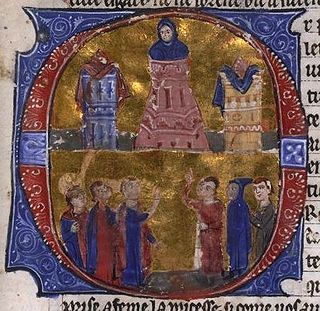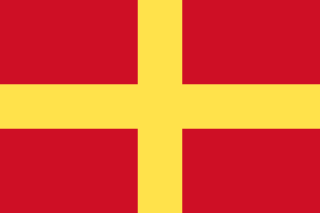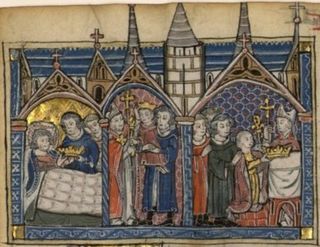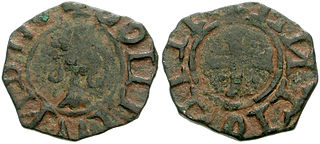| Montferrand | |
|---|---|
| Baarin, Syria | |
| Coordinates | 34°57′1″N36°24′58″E / 34.95028°N 36.41611°E |
| Type | Castle |
| Site information | |
| Condition | Ruins |
Montferrand was a fortress in the County of Tripoli (at the present-day village of Baarin in Syria), built in 1126.
| Montferrand | |
|---|---|
| Baarin, Syria | |
| Coordinates | 34°57′1″N36°24′58″E / 34.95028°N 36.41611°E |
| Type | Castle |
| Site information | |
| Condition | Ruins |
Montferrand was a fortress in the County of Tripoli (at the present-day village of Baarin in Syria), built in 1126.
The construction of Montferrand started when the united crusader troops from Jerusalem, Tripoli and Antioch laid siege to Rafaniya on 13 March 1126. [1] Originally, it was destined to complete the blockade of Rafaniya and to secure the protection of the besiegers. [1] Rafaniya fell to the crusaders on 31 March. [1]
Count Raymond II of Tripoli granted his claims to Montferrand and Rafaniya to the Knights Hospitallers in 1142 to persuade them to make efforts to recapture it. [2] In 1238/9, the Ayyubid emir of Hama, Al-Muzaffar Mahmud, decided to raze the citadel to the ground. [3]

Baldwin I was the first count of Edessa from 1098 to 1100 and king of Jerusalem from 1100 to his death in 1118. He was the youngest son of Eustace II, Count of Boulogne, and Ida of Lorraine and married a Norman noblewoman, Godehilde of Tosny. He received the County of Verdun in 1096, but he soon joined the crusader army of his brother Godfrey of Bouillon and became one of the most successful commanders of the First Crusade.

Raynald of Châtillon, also known as Reynald or Reginald, was a knight of French origin who became Prince of Antioch from 1153 to 1160 or 1161 and Lord of Oultrejordain from 1175 until his death. The second son of a French noble family, he joined the Second Crusade in 1147, and settled in the Kingdom of Jerusalem as a mercenary. Six years later, he married Constance, Princess of Antioch, in spite of her subjects' opposition.

Baldwin II, also known as Baldwin of Bourcq or Bourg, was Count of Edessa from 1100 to 1118, and King of Jerusalem from 1118 until his death. He accompanied his cousins Godfrey of Bouillon and Baldwin of Boulogne to the Holy Land during the First Crusade. He succeeded Baldwin of Boulogne as the second count of Edessa when he left the county for Jerusalem following his brother's death. He was captured at the Battle of Harran in 1104. He was held first by Sökmen of Mardin, then by Jikirmish of Mosul, and finally by Jawali Saqawa. During his captivity, Tancred, the Crusader ruler of the Principality of Antioch, and Tancred's cousin, Richard of Salerno, governed Edessa as Baldwin's regents.

The Crusader states, also known as Outremer, were four Catholic realms in the Middle East that lasted from 1098 to 1291. These feudal polities were created by the Latin Catholic leaders of the First Crusade through conquest and political intrigue. The four states were the County of Edessa (1098–1150), the Principality of Antioch (1098–1268), the County of Tripoli (1102–1289), and the Kingdom of Jerusalem (1099–1291). The Kingdom of Jerusalem covered what is now Israel, the West Bank, the Gaza Strip, western Jordan, and adjacent areas. The other northern states spanned the coastal areas of what are now Syria, southeastern Turkey, and Lebanon. The description "Crusader states" can be misleading, as from 1130 very few of the Frankish population were crusaders. The term "Outremer", used by medieval and modern writers as a synonym, is derived from the French for overseas.

The County of Tripoli (1102–1289) was the last of the Crusader states. It was founded in the Levant in the modern-day region of Tripoli, northern Lebanon and parts of western Syria. When the Frankish Crusaders – mostly southern French forces – captured the region in 1109, Bertrand of Toulouse became the first count of Tripoli as a vassal of King Baldwin I of Jerusalem. From that time, the rule of the county was decided not strictly by inheritance but by factors such as military force, favour and negotiation. In 1289 the County of Tripoli fell to Sultan Qalawun of the Muslim Mamluks of Cairo. The county was absorbed into Mamluk Egypt.

Raymond III was count of Tripoli from 1152 to 1187. He was a minor when Nizari Assassins murdered his father, Raymond II of Tripoli. Baldwin III of Jerusalem, who was staying in Tripoli, made Raymond's mother, Hodierna of Jerusalem, regent. Raymond spent the following years at the royal court in Jerusalem. He reached the age of majority in 1155, after which he participated in a series of military campaigns against Nur ad-Din, the Zengid ruler of Damascus. In 1161 he hired pirates to pillage the Byzantine coastline and islands to take vengeance on Byzantine Emperor Manuel I Komnenos, who had refused to marry his sister Melisende. He was captured in the Battle of Harim by Nur ad-Din's troops on 10 August 1164, and imprisoned in Aleppo for almost ten years. During his captivity, Amalric I of Jerusalem administered the county of Tripoli on his behalf.

Krak des Chevaliers, is a medieval castle in Syria and one of the most important preserved medieval castles in the world. The site was first inhabited in the 11th century by Kurdish troops garrisoned there by the Mirdasids. In 1142 it was given by Raymond II, Count of Tripoli, to the order of the Knights Hospitaller. It remained occupied by them until it was reconquered by the Muslims in 1271.

Raymond II was count of Tripoli from 1137 to 1152. He succeeded his father, Pons, Count of Tripoli, who was killed during a campaign that a commander from Damascus launched against Tripoli. Raymond accused the local Christians of betraying his father and invaded their villages in the Mount Lebanon area. He also had many of them tortured and executed. Raymond was captured during an invasion by Imad ad-Din Zengi, atabeg of Mosul, who gained the two important castles of Montferrand and Rafaniya in exchange for his release in the summer of 1137.

Pons was count of Tripoli from 1112 to 1137. He was a minor when his father, Bertrand, died in 1112. He swore fealty to the Byzantine Emperor Alexios I Komnenos in the presence of a Byzantine embassy. His advisors sent him to Antioch to be educated in the court of Tancred of Antioch, ending the hostilities between the two crusader states. Tancred granted four important fortresses to Pons in the Principality of Antioch. Since Pons held his inherited lands in fief of the kings of Jerusalem, Tancred's grant strengthened the autonomy of the County of Tripoli. On his deathbed, Tancred also arranged the marriage of his wife, Cecile of France, to Pons.

Bohemond III of Antioch, also known as Bohemond the Child or the Stammerer, was Prince of Antioch from 1163 to 1201. He was the elder son of Constance of Antioch and her first husband, Raymond of Poitiers. Bohemond ascended to the throne after the Antiochene noblemen dethroned his mother with the assistance of the lord of Armenian Cilicia, Thoros II. He fell into captivity in the Battle of Harim in 1164, but the victorious Nur ad-Din, atabeg of Aleppo released him to avoid coming into conflict with the Byzantine Empire. Bohemond went to Constantinople to pay homage to Manuel I Komnenos, who persuaded him to install a Greek Orthodox patriarch in Antioch. The Latin patriarch of Antioch, Aimery of Limoges, placed Antioch under interdict. Bohemond restored Aimery only after the Greek patriarch died during an earthquake in 1170.

Bohemond IV of Antioch, also known as Bohemond the One-Eyed, was Count of Tripoli from 1187 to 1233, and Prince of Antioch from 1201 to 1216 and from 1219 to 1233. He was the younger son of Bohemond III of Antioch. The dying Raymond III of Tripoli offered his county to Bohemond's elder brother, Raymond, but their father sent Bohemond to Tripoli in late 1187. Saladin, the Ayyubid sultan of Egypt and Syria, conquered the county, save for the capital and two fortresses, in summer 1188.

Cecile of France was a French princess, daughter of Philip I of France and Bertrade de Montfort.

Guillaume de Beaujeu, aka William of Beaujeu was the 21st Grand Master of the Knights Templar, from 1273 until his death during the siege of Acre in 1291. He was the last Grand Master to preside in Palestine.
Plivain, also known as Plivano or Pleban, was the lord of Botrun in the County of Tripoli from around 1180 to around 1206. He was a merchant from Pisa who settled in the county in the late 1170s. He seized Botrun through his marriage to its heiress, Lucia. According to a late source, he bribed Lucia's suzerain, Count Raymond III of Tripoli, into allowing the marriage. He fell into captivity in the Battle of Hattin on 4 July 1187.
The Lordship of Botrun was a fief around the small town of Botrun in the County of Tripoli. The crusaders occupied Botrun in 1104, then the lordship was formed in 1115, until it was seized by the Mamluks of Qalawun in 1289.
Eschiva of Bures, also known as Eschiva II, was Princess of Galilee in the Kingdom of Jerusalem from 1158 to 1187.

The timeline of the Principality of Antioch is a chronological list of events of the history of the Principality of Antioch.
Rainald I Masoir, also known as Renaud I Masoir, was constable of the Principality of Antioch from around 1126, and also baillif of the principality from 1132. Although he was a prominent military commander and held important offices, most details of his life are unknown. He received his first estates in the southern regions of Antioch in the 1110s. He made the strong fortress of Margat the center of his domains. He regularly witnessed the Antiochene rulers' diplomas from the 1120s. He was most probably still the actual ruler of the principality when he died.
The siege of Aleppo by Baldwin II of Jerusalem and his allies lasted from 6 October 1124 to 25 January 1125. It ended in a Crusader withdrawal following the arrival of a relief force led by Aqsunqur al-Bursuqi.
The siege of Beirut was an event in the aftermath of the First Crusade. The coastal city of Beirut was captured from the Fatimids by the forces of Baldwin I of Jerusalem on 13 May 1110, with the assistance of Bertrand of Toulouse and a Genoese fleet.